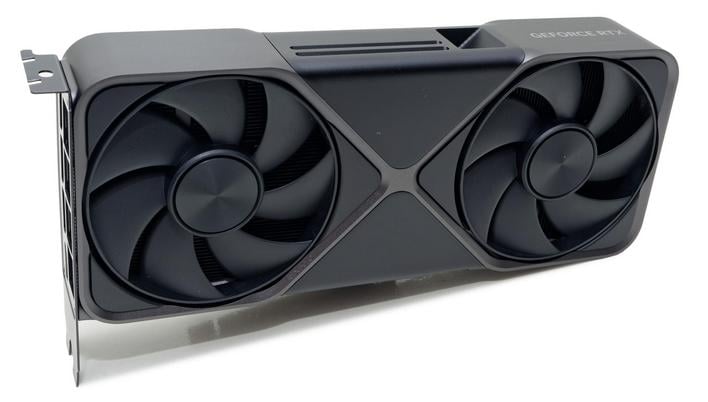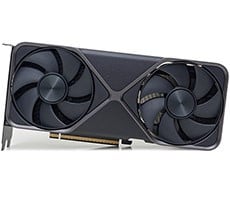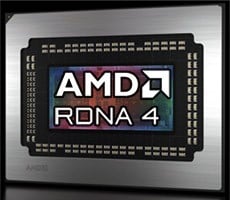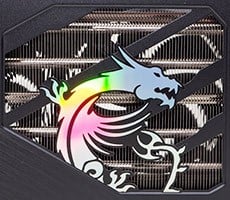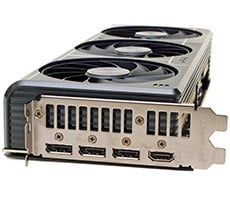GeForce RTX 5070 FE Review: NVIDIA’s More Affordable Blackwell Tested
We also spent some time overclocking the GeForce RTX 5070 FE to wring out some additional performance from its GB205 GPU and GDDR7 memory. We had great success overclocking with the RTX 5080 and RYX 5070 Ti, and were eager to see what the smallest Blackwell GPU could do...
Overclocking The GeForce RTX 5070 FE
As we've already mentioned in numerous articles at this point, Blackwell-based GeForce RTX 50 series cards feature GPU Boost, which scales frequencies and voltages up and down, based on the GPU's workload at the time -- power and temperatures permitting. Should a temperature or power limit be reached, GPU Boost will drop down to the previous boost frequency and voltage stepping, in an attempt to bring power and temperatures down gradually and not cause any significant swings in performance.
To overclock an RTX 50 series card, the maximum boost clock, the memory clock, and power limit can be tweaked to increase performance. Altering the fan speed curve and GPU voltage (when applicable) can allow for further tuning when supported.
Like previous-gen cards, the GeForce RTX 5070 FE is usually voltage or power limited to prevent damage and ensure longevity, and it's those limits that will usually determine your success when overclocking. You can see the card hitting those limits in its stock configuration above. With the GeForce RTX 5070 FE, the power target can be increased by up to 10%, but the GPU voltage could not be altered, at least not in the latest beta version of MSI's Afterburner we used. That said, we were able to increase the GPU and memory clocks quite a bit over their default values, in addition to cranking up that power limit.
We upped the power target to its maximum (110%) and used the GPU and memory frequency offsets in Afterburner to manually alter the GeForce RTX 5070 FE's frequencies. We increased the GPU and memory clock offsets incrementally until the test system was no longer stable, showed on-screen artifacts, or performance peaked due to hitting a power or other limit.
In its stock configuration, the GeForce RTX 5070 FE hit a 2,475MHz boost clock and peaked at 72°C, while maintaining its 28Gbps memory data rate (effective 14,000MHz). While overclocked, however, we were able to take its GPU clock all the way up to 2,850MHz with a 28.8Gbps memory speed.
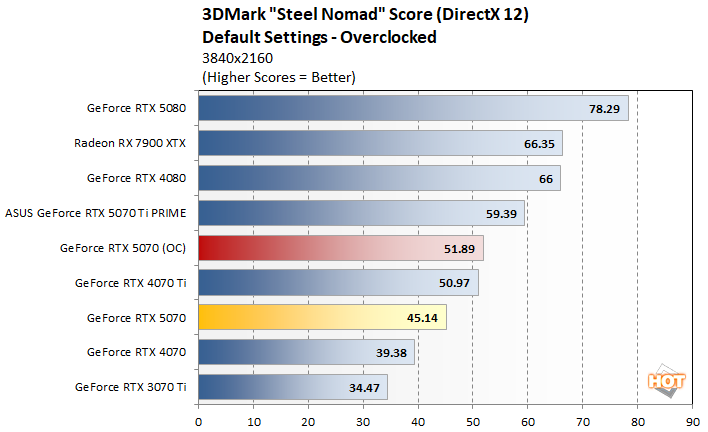
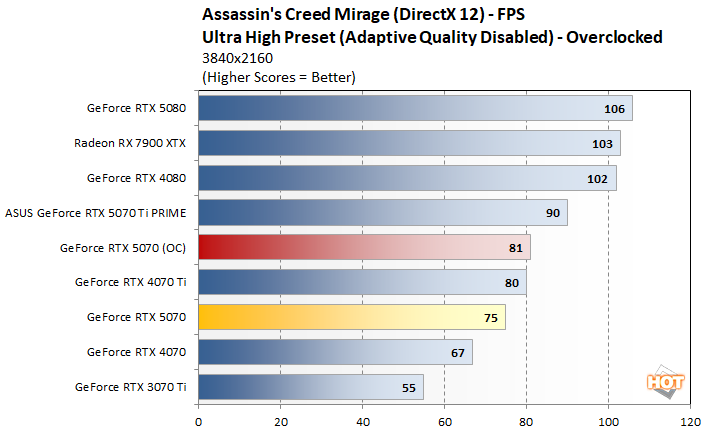
With the GeForce RTX 5070 FE overclocked, we re-ran some benchmarks and saw some really nice performance gains, in the neighborhood of 8% - 15%. Just like the RTX 5080 and RTX 5070 Ti, it appears NVIDIA is being somewhat conservative with the RTX 5070's recommended clocks and power limit.
We should also mention, that while overclocked the GeForce RTX 5070 FE remained relatively cool. We saw temperatures peak at 74°C, which was only a couple of degrees higher than stock and the fan speed maxed out at only 48%.
Total System Power Consumption
Throughout all of our benchmarking and testing, we also monitored noise output and tracked how much power the GPUs were consuming in our test system. Our goal here is to give you an idea as to how much power each GPU used while idle and also while under a heavy workload.
The GeForce RTX 5070 FEs power consumption was only slightly higher than its predecessor, and the second lowest of the group. Despite outperforming the RTX 4070 and older RTX 3070 Ti across the board, power use was only slightly higher than the RTX 4070's, but way lower than the older RTX 3070 Ti.
Noise isn't a concern with GeForce RTX 5070 FE either. At idle or when under light loads, the card is effectively silent. It's fans spin down considerably when idle, and it's basically inaudible over the other fans in a system. When under a heavy, sustained workload, the GeForce RTX 5070 FE's fans will spin up, but we would not consider it loud by any means. It is audible, but is relatively tame versus high-end GPUs.GeForce RTX 5070 FE Review Summary & Conclusions
At this point, anyone paying attention to the consumer GPU market should know what NVIDIA's GeForce RTX 5070 FE is all about. Like the other members of the GeForce RTX 50 series, the GeForce RTX 5070 FE offers a modest upgrade in rasterization performance over the previous-gen GeForce RTX 4070, though it's a much larger upgrade for gamers that are still rocking a GeForce RTX 3070 Ti or lower-end RTX 30 series card. If you factor in creator workloads, ray tracing, or the potential upsides of DLSS 4, however, the GeForce RTX 5070 FE’s value proposition looks a bit better. If you’re running a GeForce RTX 40 series card though, the GeForce RTX 5070 FE may not be compelling enough for current owners of an RTX 4070 or lower. The launch of this card is also happening while AMD’s newest RDNA 4-based Radeon 9070s loom, which will play in the same price bracket, so waiting to see how those cards shape-up versus the RTX 5070 is also advisable.In the end, the GeForce RTX 5070 FE assumes a similar profile as the other, higher-end GeForce RTX 50 series cards. It’s faster, more capable, and more power-efficient than its previous generation counterpart. However, without leveraging DLSS 4’s multi frame generation, its generational performance uplift is smaller than what we’ve historically seen from NVIDIA.




